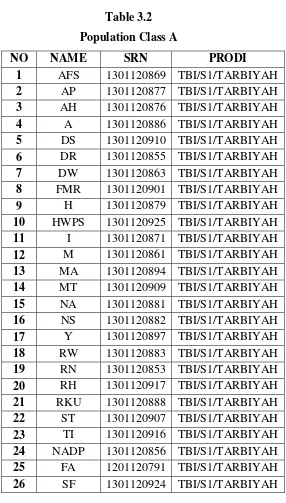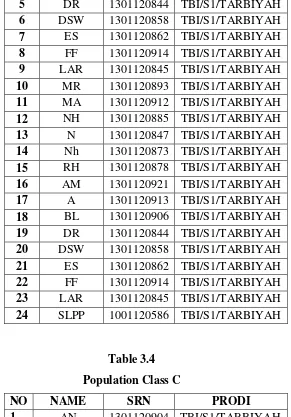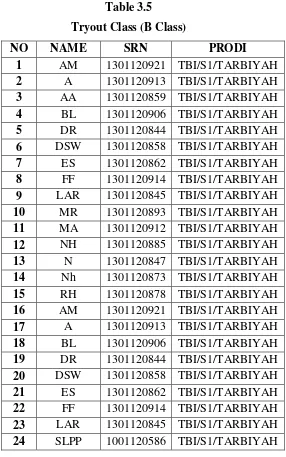25
In this part, the writer described research method that consist of design of research type, research design, population and sample, research instrument, data collecting procedure, and data analysis procedure.
A. Research Type
The study type was quantitative research. The writer chose quantitative approach because this used number and statistic to get the data. According to Ary et al, quantitative research deals with questions of relationship, cause and effect, or current status that writer can answer by gathering and statistically analyzing numeric data.1 In this study the research used non-experimental quantitative research, and identified variables also look for the level of mastery. It was the study which purposed to know what the level of vocabulary mastery the third semester students of Islamic Education the Study Programs of English Education IAIN Palangka Raya.
B. Research Design
The approach that writer chose descriptive approach. Descriptive research attempts to describe systematically a situation, problem, phenomenon, service
1
or programme, or provides information about, say, living condition of a community, or describes attitudes towards an issue2.
C. Population
Population is the group of people who want to get generalize to.3 Population is the area in which people try to get information from. According to Lodico et al., “Population is the larger group to which the writer would like the results of a study to be generalizable. In this study, all or the population was the students of Islamic Education the Study Programs of English Education IAIN Palangka Raya are 369 students by uneven semesters. That’s contain students semester I (81), semester III (72), semester V (87), semester VII (70), and semester XI (62). Base on the result of all semester, the writer containing to semester III, 72 students base on their background knowledge
they can classified into three group that’s are like three class contain 27
students in A class, 24 students in B class, and 21 students in C class. Specifically, it can be seen in this following table.
Table 3.1
The Number Students of English Education Study Program No Semester Quantity
1 Semester I 81
2 Semester III 72
3 Semester V 84
4 Semester VII 70
5 Semester IX 62
Total 369
2
Dawson, Catherine, 2002, Practical Research Methods, New Delhi, UBS
Publishers’Distributors 3
Table 3.2 Population Class A
NO NAME SRN PRODI
1 AFS 1301120869 TBI/S1/TARBIYAH 2 AP 1301120877 TBI/S1/TARBIYAH 3 AH 1301120876 TBI/S1/TARBIYAH
4 A 1301120886 TBI/S1/TARBIYAH
5 DS 1301120910 TBI/S1/TARBIYAH 6 DR 1301120855 TBI/S1/TARBIYAH 7 DW 1301120863 TBI/S1/TARBIYAH 8 FMR 1301120901 TBI/S1/TARBIYAH
9 H 1301120879 TBI/S1/TARBIYAH
10 HWPS 1301120925 TBI/S1/TARBIYAH 11 I 1301120871 TBI/S1/TARBIYAH 12 M 1301120861 TBI/S1/TARBIYAH 13 MA 1301120894 TBI/S1/TARBIYAH 14 MT 1301120909 TBI/S1/TARBIYAH 15 NA 1301120881 TBI/S1/TARBIYAH 16 NS 1301120882 TBI/S1/TARBIYAH 17 Y 1301120897 TBI/S1/TARBIYAH 18 RW 1301120883 TBI/S1/TARBIYAH 19 RN 1301120853 TBI/S1/TARBIYAH 20 RH 1301120917 TBI/S1/TARBIYAH 21 RKU 1301120888 TBI/S1/TARBIYAH 22 ST 1301120907 TBI/S1/TARBIYAH 23 TI 1301120916 TBI/S1/TARBIYAH 24 NADP 1301120856 TBI/S1/TARBIYAH 25 FA 1201120791 TBI/S1/TARBIYAH 26 SF 1301120924 TBI/S1/TARBIYAH
Table 3.3 Population Class B
NO NAME SRN PRODI
1 AM 1301120921 TBI/S1/TARBIYAH
2 A 1301120913 TBI/S1/TARBIYAH
5 DR 1301120844 TBI/S1/TARBIYAH 6 DSW 1301120858 TBI/S1/TARBIYAH 7 ES 1301120862 TBI/S1/TARBIYAH 8 FF 1301120914 TBI/S1/TARBIYAH 9 LAR 1301120845 TBI/S1/TARBIYAH 10 MR 1301120893 TBI/S1/TARBIYAH 11 MA 1301120912 TBI/S1/TARBIYAH 12 NH 1301120885 TBI/S1/TARBIYAH 13 N 1301120847 TBI/S1/TARBIYAH 14 Nh 1301120873 TBI/S1/TARBIYAH 15 RH 1301120878 TBI/S1/TARBIYAH 16 AM 1301120921 TBI/S1/TARBIYAH 17 A 1301120913 TBI/S1/TARBIYAH 18 BL 1301120906 TBI/S1/TARBIYAH 19 DR 1301120844 TBI/S1/TARBIYAH 20 DSW 1301120858 TBI/S1/TARBIYAH 21 ES 1301120862 TBI/S1/TARBIYAH 22 FF 1301120914 TBI/S1/TARBIYAH 23 LAR 1301120845 TBI/S1/TARBIYAH 24 SLPP 1001120586 TBI/S1/TARBIYAH
Table 3.4 Population Class C
NO NAME SRN PRODI
1 AN 1301120904 TBI/S1/TARBIYAH
2 A 1301120895 TBI/S1/TARBIYAH
3 AA(?) 1301120859 TBI/S1/TARBIYAH 4 BAF 1301120896 TBI/S1/TARBIYAH 5 DTH 1301120857 TBI/S1/TARBIYAH 6 DKN 1301120889 TBI/S1/TARBIYAH
7 EA 1301120860 TBI/S1/TARBIYAH
8 FM 1301120923 TBI/S1/TARBIYAH
9 IR (?) 1311120841 TBI/S1/TARBIYAH 10 IS 1301120868 TBI/S1/TARBIYAH
11 K 1301120852 TBI/S1/TARBIYAH
15 R 1301120890 TBI/S1/TARBIYAH 16 RR 1301120926 TBI/S1/TARBIYAH 17 RN 1301120891 TBI/S1/TARBIYAH
18 S 1301120872 TBI/S1/TARBIYAH
19 SH 1301120866 TBI/S1/TARBIYAH 20 SM 1301120851 TBI/S1/TARBIYAH 21 TT 1301120865 TBI/S1/TARBIYAH 22 WN 1301120875 TBI/S1/TARBIYAH
D. Sample
Lodico et al., said that: Sample is a smaller group selected from a larger population (in this case, a realistic population) that is representative of the larger population.4 The sample of this study was the third semester students of Islamic Education the Study Programs of English Education IAIN Palangka Raya. The number of population was about 72 students. It is classified into three classes. Since there was 3 classes in third semester. So the writer minimized the object that will be sample into 1 class for instrumentation tryout, before choosing the research class. The sample in this research was chosen by using cluster random sampling. Cluster sampling, according to Ary, et al., is where the unit chosen is not an individual but, rather, a group of individuals who are naturally together.5
4
Marguerite G. Lodico, Dean T. Spaulding, Katherine H. Voegtle, Methods In Educational Research, San Francisco: Jossey-Bass, 2006, P. 13
5
Table 3.5
Tryout Class (B Class)
NO NAME SRN PRODI
1 AM 1301120921 TBI/S1/TARBIYAH
2 A 1301120913 TBI/S1/TARBIYAH
3 AA 1301120859 TBI/S1/TARBIYAH 4 BL 1301120906 TBI/S1/TARBIYAH 5 DR 1301120844 TBI/S1/TARBIYAH 6 DSW 1301120858 TBI/S1/TARBIYAH 7 ES 1301120862 TBI/S1/TARBIYAH 8 FF 1301120914 TBI/S1/TARBIYAH 9 LAR 1301120845 TBI/S1/TARBIYAH 10 MR 1301120893 TBI/S1/TARBIYAH 11 MA 1301120912 TBI/S1/TARBIYAH 12 NH 1301120885 TBI/S1/TARBIYAH 13 N 1301120847 TBI/S1/TARBIYAH 14 Nh 1301120873 TBI/S1/TARBIYAH 15 RH 1301120878 TBI/S1/TARBIYAH 16 AM 1301120921 TBI/S1/TARBIYAH 17 A 1301120913 TBI/S1/TARBIYAH 18 BL 1301120906 TBI/S1/TARBIYAH 19 DR 1301120844 TBI/S1/TARBIYAH 20 DSW 1301120858 TBI/S1/TARBIYAH 21 ES 1301120862 TBI/S1/TARBIYAH 22 FF 1301120914 TBI/S1/TARBIYAH 23 LAR 1301120845 TBI/S1/TARBIYAH 24 SLPP 1001120586 TBI/S1/TARBIYAH
E. Research Instrument
material given. Because multiple choice can make object of the study so be fluently to understanding the writer not used writing, reading, listening, or speaking for support the research because mastery vocabulary must to known
before to applied that’s skills for English devolving.
a. Research Instrument Test
The main data of this study was the data of the students’ vocabulary mastery. In order to get the data, the writer conducted a test. It was conducted after the writer measure the validity and reliability of the test instrument. The test was done in three classes. The test was constructed in the form of multiple choice item which consisted of 100 items of test, include in the test three kinds of vocabulary such as noun, verb, and adjective. Moreover, the test was done in four classes, those were; A class (Tuesday / November 11, 2014), B class (Tuesday / November 18, 2014), and C class (Tuesday / November 25, 2014).
The writer gave the test to the third Semester Students of Islamic Education the Study Programs of English Education IAIN Palangka Raya. Based on the result, it is known that the highest score was and the lowest score and the mean score of the test result.
Table 3.6
The Number Students of Third Semester No Class Quantity
1 A 23
2 B 20
3 C 18
The test was constructed in the from of multiple choice which consisted of 100 items test. 23 items of noun, 48 items of verb, and 29 items of adjective. The writer took this tree kinds of vocabulary because they were included as Four Main Forms of Word consist of noun, verb, adjective and adverb. In addition, she adjusted the test with vocabulary level test (VLT) that was developed by Schmitt.6
Table 3.7
The Content of Specipication Items No Indicators Items Percentage
1 Noun 23 23%
b. Research Instrument Try Out
The writer tried out the test instrument before it was applied to the real sample of the study. The writer take the result of random sampling into B class. And then tryout test was given to the students at IAIN Palangka Raya on 31 October 2014. In this case, the students were assigned to do a vocabulary test which consist of three parts such as noun, verb and adjective. The value of the tryout test are 140 questions. They were required to match the answer and questions with a suitable choice. Because the writer would known what are information of the
question that’s in category easy, medium, or so hard. Then, the writer
gave score and analyzed data to check the validity, reliability, and index of difficulty of the instrument. There were some procedures as bellow: 1. The writer prepared test instrument
2. The writer gave try out tothe respondents 3. The writer collected the answer and gave score 4. The writer calculated the result of the test
5. The writer analyzed the data obtained to know the instrument validity, reliability, and index of difficulty
6. After that all. The writer knew the valid and invalid items, and revised the invalid items to be tested to the real smple of the test c. Research Instrument Reliability
According to Ary, “Reliability is concerned with the effect of error
whatever it is measuring.7 Reliability is necessary characteristic of any good test: for it to be valid all, a test must be reliable as a measuring instrument.8 The writer examined reliability of the item by using conbrach alpha and spss 16. So, the formula is:
r
11=
(
𝑘𝑘−1
) (1
–
Ʃ𝑆𝑖2𝑆𝑡
)
Where:
r11 =Reliability Value
k = Number Items of the test
Ʃ𝑆𝑖2 = Sum of Variances of the Item Score
St = Variance of the Test Scores (all K items) d. Index of Difficulties
Index of difficulties is used to know how difficult or easy of the test items are. To know the level of difficulty of the test and the formula used is:
F.V =
𝑅𝑁
F.V = Facility Value
R = Represent the Number of Correct Answer N = The Number of the Students
7
Donal Ary, Introduction to research in Education, second edition, New York, p. 237.
8
It will be classified as:
F.V 0,00 – 0,30 = Difficult F.V 0,30 – 0,70 = Fair F.V 0,70 – 1,00 = Easy e. Research Instrument Validity
Instrument validity discuss about content validity and construct validities of the test which use in the research.9 Validity refers to the extent to which an instrument measures what it is intended to measure.10 An instrument is consider being a good one of it meets some requirement. One of them is validity. Validity is a Measurement Which Shows the grades of number of an Instrument.nA valid Instrument must have high validity, it means that an Instrument Which lacks validity is said to be Invalid instrument.
a) Content Validity
According to Heaton, content validity is:
Kinds of validity depends on a careful analysis of the being test and
the particular course objective. The test should be as constructed as
contain a representative sample of the course, the relationship
between the test item and the course objectives always being
apparent.11
9
Ibid., p. 106.
10
Donal Ary, Introduction to Research in Education, second edition, New York, p.196.
11
In this study, the writer used multiple choice item. Which match with suitable answer to the questions. The writer analyzed and scored the
answers to know the students’ level of vocabulary mastery.
b) Construct Validity
Construct validity is a slightly more complex issue related to the internal structure of an instrument and the concept it is measure. It is related to our theoretical knowledge of the concept. In order, to know the degree of the validity of the test items based on the coefficient correlation. To find the validity of the test, the formula is used is:
r
xy = 𝑁Σ𝑋𝑌− Σ𝑋 (Σ𝑌)
{𝑁Σ𝑋2− (Σ𝑋)2}{𝑁Σ𝑌2− (Σ𝑋)2}
Notice :
rxy : The Coefficient of Correlation
∑X : Total Value of Score X
∑Y : Total Value of Score Y
∑XY : Multiplication Result between Score X and Score Y
To know the validity level of the instrument, the result of the test would be interprets to the criteria as follows.12
Table. 3.8
The Interpretation of Correlation Pearson Product Moment
Coefission Criteria
0.800 – 1.000 Very High Validity 0.600 – 0.799 High Validity 0.400 – 0.599 Fair VaLidity 0.200 – 0.399 Poor Validity 0.001 – 0.199 Very Poor Validity
F. Data Collection Procedure
First, the writer gave the test item of vocabulary to the students who became sample in this study. After that, the writer collected the results of the test given to them after filling out the test item.
1) The writer prepared the instrument.
2) The writer held the tryout test to the students. 3) The writer gave score to the students answer sheet.
4) The writer calculated the result of the test by using formula.
5) The writer analyzed the data obtained to know the instrument validity and instrument reliability.
6) If the result is valid, it means that the test item as the instrument of this study are suitable to be given.
12
G. Data Analysis Procedure
In this chapter the writer presented and analyzed the data which has been
collected from the test. This gave much information about the students’
mastery on the English Vocabulary at the Third Semester Students Study Program at IAIN Palangka Raya in academic year 2013/2014.
In analyzing the data this study used quantitative method. In quantitative data analysis the writer used the percentage procedure. It is used to find out how many students mastery the material of the test.
a. Editing is recheck the correctness of the data that has been gathered. b. Tabulating is collecting and listing data into table.
c. Scoring the data. In this case, each item gets 1 point. The number of the items is 100. So, the total score is 100. To get the score, the formula is: Score = The Total of the Right Answers x 1
d. Finding the average score of the students’ vocabulary mastery, the formula is:
S
=
𝑅𝑁
Notes:
S = The Average Score of the Students’ Mastery R = The Total Students’ Score (the right answers) N = The Number of Students
Table 3.9
Distribution Frequency and Presentation Score of the Students’ Mastery Level in Vocabulary Size of IAIN Palangka Raya
No Level Interpretation Letter Value
1 80 – 100 Very Good A
2 70 - < 80 Good B
3 60 - < 70 Fair C
4 50 - < 60 Poor D
5 0 - < 50 Very Poor E
f. Making conclusion about the students’ vocabulary mastery.
In quantitative data analysis the writer used technique deal with non- numerical data. The analysis is done by
(1) Describing the instrument and data expected from the research (2) Presenting the factual found in the data research






